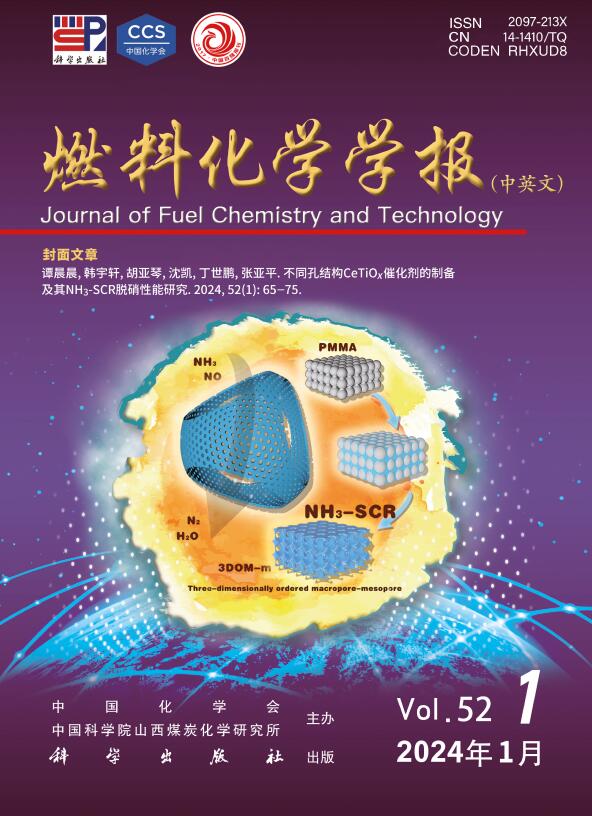De novo-design of highly exposed Co−N−C single-atom catalyst for oxygen reduction reaction
Q3 Energy
引用次数: 0
Abstract
The nitrogen-coordinated metal single-atom catalysts (M−N−C SACs) with an ultra-high metal loading synthetized by direct high-temperature pyrolysis have been widely reported. However, most of metal single atoms in these catalysts were buried in the carbon matrix, resulting in a low metal utilization and inaccessibility for adsorption of reactants during the catalytic process. Herein, we reported a facile synthesis based on the hard-soft acid-base (HSAB) theory to fabricate Co single-atom catalysts with highly exposed metal atoms ligated to the external pyridinic-N sites of a nitrogen-doped carbon support. Benefiting from the highly accessible Co active sites, the prepared Co−N−C SAC exhibited a superior oxygen reduction reactivity comparable to that of the commercial Pt/C catalyst, showing a high turnover frequency (TOF) of 0.93 e−·s−1·site−1 at 0.85 V vs. RHE, far exceeding those of some representative SACs with an ultra-high metal content. This work provides a rational strategy to design and prepare M−N−C single-atom catalysts featured with high site-accessibility and site-density.
用于氧还原反应的高暴露Co - N - C单原子催化剂的重新设计
采用直接高温热解法合成的超高金属负载量的氮配位金属单原子催化剂(M−N−C SACs)已被广泛报道。然而,这些催化剂中的金属单原子大多埋藏在碳基体中,导致金属利用率低,催化过程中反应物难以吸附。本文报道了一种基于硬-软酸碱(HSAB)理论的简单合成方法,将高度暴露的金属原子连接到氮掺杂碳载体的外部吡啶- n位上,制备了Co单原子催化剂。由于Co活性位点易于接近,所制备的Co - N - C SAC表现出与商用Pt/C催化剂相当的优异氧还原活性,在0.85 V / RHE下,其转换频率(TOF)高达0.93 e−·s−1·site−1,远远超过了一些具有超高金属含量的代表性SAC。本研究为设计和制备具有高位点可及性和高位点密度的M−N−C单原子催化剂提供了一种合理的策略。
本文章由计算机程序翻译,如有差异,请以英文原文为准。
求助全文
约1分钟内获得全文
求助全文
来源期刊

燃料化学学报
Chemical Engineering-Chemical Engineering (all)
CiteScore
2.80
自引率
0.00%
发文量
5825
期刊介绍:
Journal of Fuel Chemistry and Technology (Ranliao Huaxue Xuebao) is a Chinese Academy of Sciences(CAS) journal started in 1956, sponsored by the Chinese Chemical Society and the Institute of Coal Chemistry, Chinese Academy of Sciences(CAS). The journal is published bimonthly by Science Press in China and widely distributed in about 20 countries. Journal of Fuel Chemistry and Technology publishes reports of both basic and applied research in the chemistry and chemical engineering of many energy sources, including that involved in the nature, processing and utilization of coal, petroleum, oil shale, natural gas, biomass and synfuels, as well as related subjects of increasing interest such as C1 chemistry, pollutions control and new catalytic materials. Types of publications include original research articles, short communications, research notes and reviews. Both domestic and international contributors are welcome. Manuscripts written in Chinese or English will be accepted. Additional English titles, abstracts and key words should be included in Chinese manuscripts. All manuscripts are subject to critical review by the editorial committee, which is composed of about 10 foreign and 50 Chinese experts in fuel science. Journal of Fuel Chemistry and Technology has been a source of primary research work in fuel chemistry as a Chinese core scientific periodical.
 求助内容:
求助内容: 应助结果提醒方式:
应助结果提醒方式:


